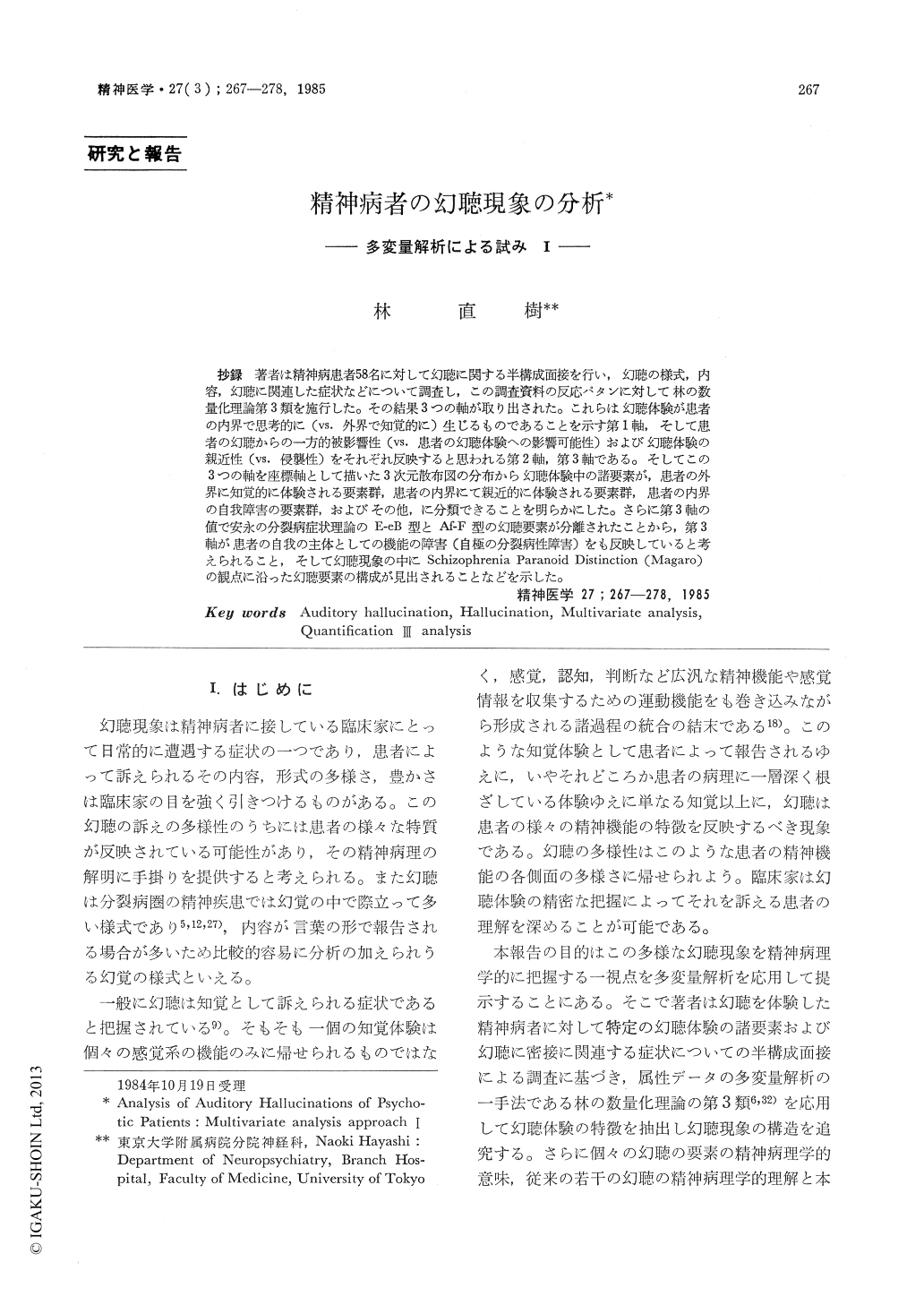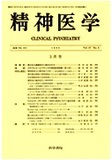Japanese
English
- 有料閲覧
- Abstract 文献概要
- 1ページ目 Look Inside
抄録 著者は精神病患者58名に対して幻聴に関する半構成面接を行い,幻聴の様式,内容,幻聴に関連した症状などについて調査し,この調査資料の反応パタンに対して林の数量化理論第3類を施行した。その結果3つの軸が取り出された。これらは幻聴体験が患者の内界で思考的に(vs. 外界で知覚的に)生じるものであることを示す第1軸,そして患者の幻聴からの一方的被影響性(vs. 患者の幻聴体験への影響可能性)および幻聴体験の親近性(vs. 侵襲性)をそれぞれ反映すると思われる第2軸,第3軸である。そしてこの3つの軸を座標軸として描いた3次元散布図の分布から幻聴体験中の諸要素が,患者の外界に知覚的に体験される要素群,患者の内界にて親近的に体験される要素群,患者の内界の自我障害の要素群,およびその他,に分類できることを明らかにした。さらに第3軸の値で安永の分裂病症状理論のE-eB型とAf-F型の幻聴要素が分離されたことから,第3軸が患者の自我の主体としての機能の障害(自極の分裂病性障害)をも反映していると考えられること,そして幻聴現象の中にSchizophrenia Paranoid Distinction(Magaro)の観点に沿った幻聴要素の構成が見出されることなどを示した。
This study aims at clarifying the multiplicity of auditory hallucinations experienced by psychotics, and to grasp their characteristics utilizing the quantification III analysis which is devised for multivariate analysis of categorized data.
Fifty-eight psychotics (male ; 48, female ; 10) were investigated with a semi-structured interview about the features and components of auditory hallucinations and their related symptoms during a specified period. In selecting subjects, it was required that each patient actually experienced auditory hallucinations and was able to recall them sufficiently to be able to give information about them. It was also required that they consented to participate in this study after being properly informed about its nature. The hallucinatory experiences were categorized and scored in accord with the items inquired about in the investigations:Item 1 facilitating content, Item 2 negative content, Item 3 neutral or ambiguous content, Item 4 imperative content, Item 5 content of a commentary nature, Item 6 sexual content, Item 7 content perceived through ears, Item 8 always accompanied by an unpleasant feeling, Item9 single voice directly speaking to Pt., Item 10 plural voices directly speaking to Pt., Item 11 voices discussing Pt., Item 12 voices conversing with Pt., Item 13 hallucinations in an actual situation, Item 14 ability to start hallucination at will, Item 15 ability to stop hallucination at will, Item 16 functional hallucination, Item 17 audible thought, Item 18 thought insertion, Item 19 thought withdrawal, Item 20 Pt's feeling that his or her thoughts are known to others.
Item 21 "Made" feeling, Item 22 delusional explanation. The quantification III analysis extracted three axes from the data. These three axes accounted for 41% of the variance. They represented (1) the location of the experience in Pt's perceptual space (internal or external space of Pt.), (2) the passivity of Pt. in or proneness towards hallucinatory experience, and (3) the degree of disturbance of Pt.'s ego autonomy in the experience.These axes can be a useful guide for us to find out the characteristics of the phenomena. The three dimension scatter diagram showing the distribution of the items from the viewpoint of the three axes, separated three groups of items : components indicating external perceptual space (Item 7, 11, 13), ego familiar components (Item 1, 2, 12, 15, 17), ego disturbance components (Item 4, 18, 19, 20, 21). Then the interrelationship among the items was discussed.
These results correspond with the findings of previous theories about the symptomatology of psychoses such as "Phantom space theory" (Yasunaga), Schizophrenia Paranoid distinction (Magaro) and other authors', and will give some clues for us to comprehend the psychopathological meanings of auditory hallucinations.

Copyright © 1985, Igaku-Shoin Ltd. All rights reserved.


